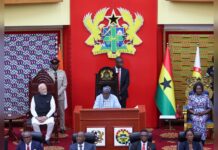Government’s second local dollar bond issuance, which raised a total US$221million for three years at 6.25percent, put the cedi under temporary pressure last week, latest RMB Research has shown
Data from the Central Bank shows that the local currency depreciated by 0.46percent against the US dollar between October 30 and November 10, 2017, a first seen since August, 2017.
The local currency was trading at GH¢4.39 against the greenback as at November 10, up from GH¢4.37 ten days earlier.
“Leading up to the well-subscribed domestic dollar-bond issuance, the Ghanaian cedi weakened against the greenback—a level last seen back in August 2017. This was because the bond was only available to domestic investors; therefore, to participate in the bond, would-be investors would have to purchase dollars, thus placing the cedi under pressure,” the South African-based research firm noted.
The research firm, a subsidiary of Rand Merchant Bank, added that the final pricing on the bond offered a competitive return relative to the current yields on the existing Eurobonds, hence the outsized issuance of US$221m.
“We expect the weakness to be temporary as this bout of weakness would have likely attracted the keen eye of the central bank that has proved ready to thwart any weakness. We expect a recouping of the losses this week,” it added.
The well subscribed bond, according to arrangers, boosts the government’s plans to explore local funding sources. Initial guidance for the bond, the second to be issued by Ghana, was open to only Ghanaian investors.
Ghana is emerging from a fiscal crisis that has left it with high deficits and a steep public debt that forced the government into a credit deal with the International Monetary Fund worth about US$918 million in 2015.
The bond, which will mature in November 2020, was issued through a joint book-building arranged by Barclays Bank, Stanbic Bank and brokerage firm Strategic African Securities (SAS) and was settled yesterday.
Ghana, last year, issued its debut dollar denominated domestic bond worth US$94.64million in two-year paper with a coupon of 6percent after an initial price range of 5.5-6.5 percent.
The local currency has been fairly stable against the greenback all year. Compared to previous years, the cedi has so far depreciated 4.38percent as against previous years.
Between 2013 and 2016, depreciation was so rampant, many currency analysts and economists described the situation as a precursor to an official dollarization of the economy.
The cedi depreciated by 17.5percent, 15.percent, 26.5percent, 15.7percent and 10percent in 2012, 2013, 2014, 2015 and 2016 respectively. Before experiencing the relative stability in 2017, the currency dropped by almost 10percent in the first quarter before rallying strongly to appreciate by 1percent in late April, 2017.
Analysts opined that, as an import driven economy, the regular depreciation of the currency over the past five years led many businesses to increasingly take refuge in the dollar.
The Central Bank, in 2014, tried, without success, to force businesses, especially hospitality facilities, real estate industry players and importers, to stop pricing in dollars and reduce significantly their dollar withdrawal from banks.
This move, according to analysts worsened the situation and further made businesses and Ghanaians lose confidence in the cedi and this resulted in the cedi depreciating by as much as 40percent in the first half of 2014 before settling at 26.5percent.
But a change of government saw renewed confidence in the economy which has seen the local currency relatively stabilise since the turn of the year. Coupled with some strategic bond sales by government to tune of US$4billion in the first half, the cedi has seen considerable respite.










